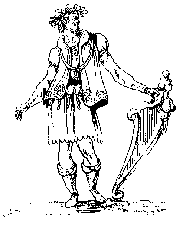

by Guy Shaked
Keywords: Giulio Caccini, Eurydice, Euridice, Monteverdi, L'Orfeo, Orpheus, Jacopo Peri, Ottavio Rinuccini, Shaked
Two of the first ever composed operas are based on the myth of Orpheus and Eurydice. These are "Euridice" by Caccini and Peri from 1600 and "Orfeo" by Monteverdi from 1607.
This article will attempt to show that the reason for the selection of this myth, is the meaning of the myth of Orfeo reviving his beloved Euridice as allegorical to the act of the revival of Greek opera by Perri, Caccini and Monteverdi.
According to the myth, shortly after the marriage of Orpheus to Eurydice, The later was bitten by a snake and died. Orpheus who was a most accomplished lyre-player followed her to the underworld. There, before the seat of Pluto and Proserpina, he sang accompanying the song on his lyre, his plea for the revival of his wife. His singing moved strongly the emotions of the ghosts and touched the heart of Pluto. Orpheus was permitted to take Eurydice to the upperworld, on the condition that he will not turn around to look at her until they have reached the upperworld. They went on their way, he was leading and shed followed him. However, when they almost have reached the earth, Orpheus cast a glance behind him to see that she was following and she was immediately taken back to the underworld [1].
This story can be interpreted as an allegory. According to an allegorical reading, Orpheus, the lyre player wants to revive ancient Greek music (Euridice) that died. After passing in darkness (the darkness of the medieval ages) who are marked by silence, Orpheus want to be certain that it is Greek music (Eurydice) that is revived and he looks one more time to examine that it is so. Because he wants to follow Greek music to an access, that he looses it (Eurydice is taken from him to the underworld).
This allegorical myth fitted well with the need of Peri and Caccini who saw themselves as reviving the ancient dead Greek music. In their opera "Orfeo", they changed the ending to an happy one. According to it, Orpheus with his talent revives successfully Eurydice (the dead Greek music) and lives with her happily ever after. Since Orpheus was a lyre player and he revives Eurydice with song accompanied to the lyre, Peri orchestrated his opera accordingly, to a thin orchestral texture, to the sound of plucked instruments like the lyre: harpsichord (gravicembalo), lira da gamba o lirone (lira grande), bass lute(liuto grosso) and chitarrone.
Unlike Peri and Caccini, Monteverdi kept the original ending of the myth. According to its allegorical meaning - Orpheus wants to make sure one more time that he is indeed reviving Eurydice (Greek Music). This is like (according to Monteverdi) Peri and Caccini who are trying too much to follow too closely Greek music (looking back again and again to the exact properties of it). Unlike them, Monteverdi orchestrated his Opera "L'Orfeo" more freely with various instruments, including instruments that did not exist in ancient Greece, not feeling the urge to look al the time and check back if it is according to Greek music exactly.
The Feast from the Opera Amnon
----------------------------------------------------------------
[1] Ovid, Metamorphoses, Frank Justus Miller tr., X, (Cambridge MA, Harvard University Press, 1946): lines 1-77
Reviews:
| REVIEWER | COMMENT |
| Dr. Jane Ennis (Goldsmiths College, London) | Fascinating, a great help with my current research on early opera |
Dear visitor, please take a short moment to sign my guest book!
Original My Biography
Biblical Opera Online : Amnon and Tamar
----------------------------------------------------------------

© 2003 shakedtg@hotmail.com Emails are
gladly received
Papageno in Mozart's "The Magic Flute" as a parody of Antonio Salieri
A translation of Girolamo
Mei's letters go Vincenzo Galilei and Giovanni Bardi
Girolamo Mei's
biography
Josquin
Des Prez : Biography; At the court of Louis XI; Two Textual layers in Josquin
's 'Tu Solus'; The Motet-Lament 'Absalon, fili mi'
Johannes Ockeghem: Biography;
S’elle m’amera-Petite camusete:A sophisticated game of meaning and structure; Polytextuality:
From Machaut to Ockeghem
Three layers of meaning in
Jacques Offenbach's "The Tales of Hoffmann"; The Automaton motive in "Tales of Hoffmann"
ABSTRACT: The
painting "Libreria Musicale" (Musical Library) by Giuseppe Maria Crespi,
as a source of information on the "Storia della Musica" (History of Music)
by Father Martini
The
music of Abraham Casseres (Jewish Music)
Music in
the Bible
Letters from the Grave:
Mozart writing to Beethoven
The harp
as a hidden symbol in Bernini's 'David'
Other articles by G. Shaked:
ART -
BIBLICAL STUDIES -
BIOLOGY
-
CINEMA
-
LITERATURE
-
MUSIC -
PHILOSOPHY
-
PHYSICS
(ACOUSTICS)